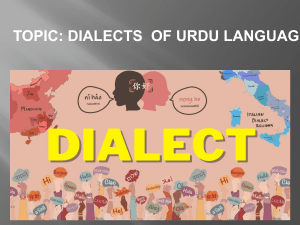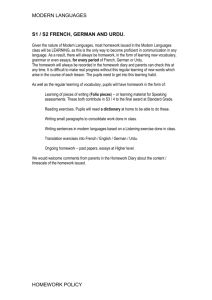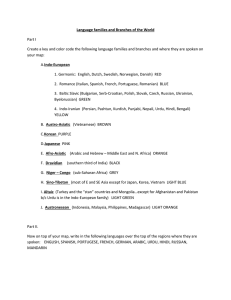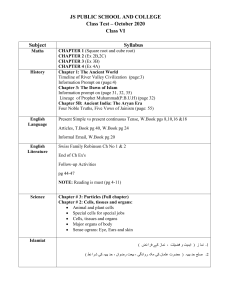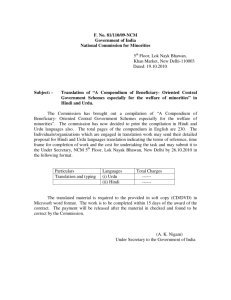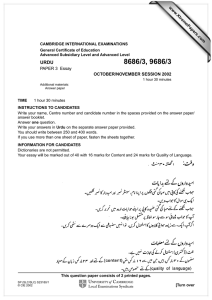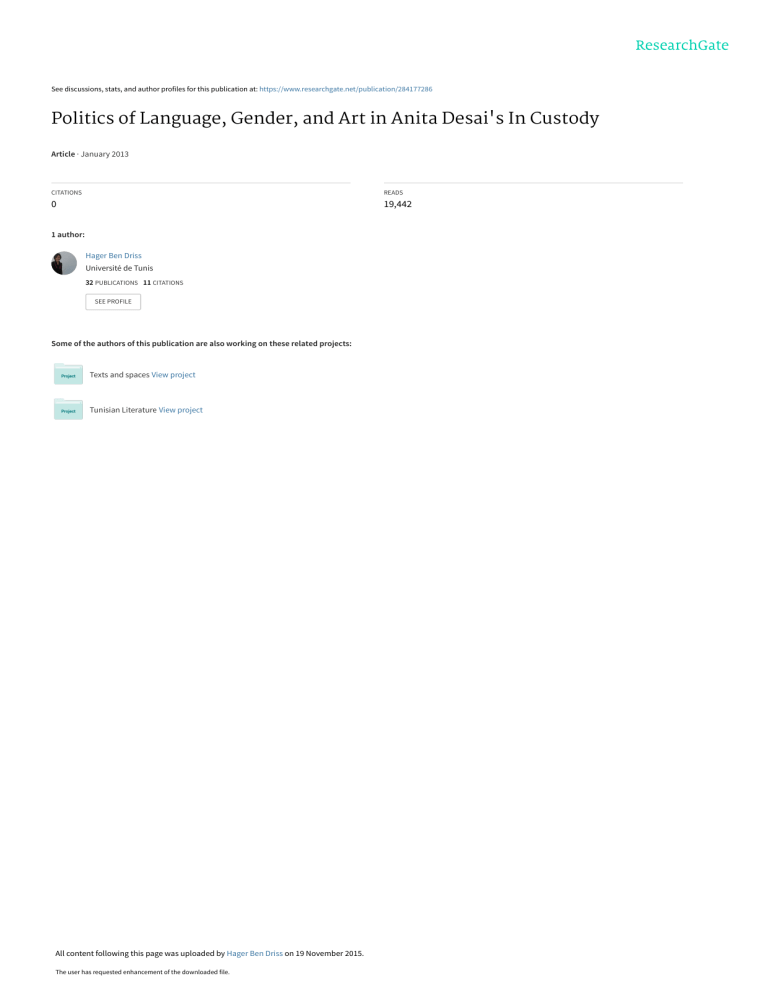
See discussions, stats, and author profiles for this publication at: https://www.researchgate.net/publication/284177286 Politics of Language, Gender, and Art in Anita Desai's In Custody Article · January 2013 CITATIONS READS 0 19,442 1 author: Hager Ben Driss Université de Tunis 32 PUBLICATIONS 11 CITATIONS SEE PROFILE Some of the authors of this publication are also working on these related projects: Texts and spaces View project Tunisian Literature View project All content following this page was uploaded by Hager Ben Driss on 19 November 2015. The user has requested enhancement of the downloaded file. Politics of Language, Gender and Art in Anita Desai’s In Custody Hager Ben Driss The slow death of my mother­ tongue, Urdu, is much further advanced than it was twenty­three years ago, and much that was beautiful in the culture of old Delhi has slipped away forever. (Salman Rushdie, “Introduction to In Custody”) I really don’t know very much about Urdu literature. I understand the language, but I don’t read or write it. My knowledge of it is very limited, but I think of it as the repository for a certain period of Indian history and a certain culture. (Anita Desai, Interviews With Writers of the Postcolonial World) Even though linguistic and religious varieties in India endow the country with a rich cultural mosaic, the cultural scene is still fraught with clashes. Indeed, competing cultures within India continue to strive for supremacy. Published almost three decades ago, Anita Desai’s novel, In Custody (1984), raises ongoing cultural anxieties besieging Indian consciousness at the present time. Desai’s narrative charts the changing social and cultural values as India moves towards a global ethos. It starts from the story of a Hindu teacher, infatuated by the decaying Urdu language and literature, to portray a marginalized minority superseded by an increasingly engulfing Hindu culture. The narrative dramatizes the highly politicized issue of languages in India and explores its social and artistic ramifications. Languages repose on a dynamic of change shaped by socio­political conflicts. Such conflicts explain the supremacy of one or some versions of the language and the exclusions of others. The language that enjoys prestige is definitely the one normalised through education, media as well as ethnic and geographical discrimination (Dentich 35). Languages in India function within the same process. Indeed, they are the repository of tensions and struggles informing cultural Journal of South Texas English Studies 4.1 (2013) 1 belonging and identity. The 1947 Partition of India resulted into a repartition of languages. The aftermath of that traumatic historical event still permeates the linguistic scene. The fraught relationship between Hindus and Muslims is re­ enacted in a conflicted relationship between Hindi and Urdu. While Hindus claim Hindi as a linguistic identity, Muslims maintain their cultural ties to Urdu. Viewed by an outsider, the situation is quite puzzling for the two languages are identical both in their spoken form and grammatical structure. They only differ “at the literary level and in speech among the educated elite in vocabulary and in script” (Brass, 184). In fact, there were attempts at bridging the gap between Urdu and Hindi by propelling Hindustani, a neutral­like language proposed by Gandhi and officially recognized by the Indian National Congress in its 1934 Constitution (Yaqin 127). The problem of script, however, has been impossible to surmount. While Urdu speakers stick to Perso­Arabic script, Hindi users refuse to depart from the Deva Nagari one. The two competing languages offer a thorny case of Diglossia, defined as a sociolinguistic situation in which more than one form of a language interacts with other forms, such that one ‘high’ form (H) is perceived as older, more prestigious, purer, more beautiful, and perhaps the only one deserving to be used for schooling, ‘high’ literature, religion, and so forth. The other ‘informal’ language (L) is different from H variety as are Latin and French, but L has no prestige and is devalued and even despised, although it is the actual ‘mother tongue’ of the population. (Schifferman 434­5) This definition, however, does not provide an accurate account of the meaning of ‘mother tongue’, deemed an irrelevant category in such a multilingual country. Ironically enough, it describes the Indian linguistic situation in a reversed way. The ‘high’ language designed to transmit culture is superseded by a ‘lower’ form. For Urdu was the language of the court and the linguistic carrier of literature and art (Bayly 124). It gained patronage at Muslim courts and developed into a literary Journal of South Texas English Studies 4.1 (2013) 2 language. Urdu emerged as a distinct language during the reign of Muslim Mughals (1526­1858) and was adopted as the official language of most of Mughal states. The demise of Urdu in India started long before the Partition. It was among the dire consequences of the 1857 Mutiny. North Indian Muslims were severely punished after the crush of the rebellion. Execution, expulsion of Muslims from Delhi, then the cultural capital of Mughal India, and the destruction of libraries all coalesced to weaken Urdu. The British colonial pernicious policy of divide to rule had also a part in the linguistic remapping of India. Separating Indian population into Hindu and Muslim communities encouraged Hindu revivalism, Pan­Islamism as well as the development of the two­nation theory culminating into the 1947 Partition (Daya 33­35). The politics of language permeates Desai’s narrative and frames all other issues. This paper proposes to analyze three intersecting discourses in Anita Desai’s novel: language, gender and art. It investigates the enmeshed relationship between the politics of language as a purveyor of identity; the politics of gender as an arena of social divide; and the politics of art as a medium of cultural articulation. Narrating an Endangered Language Anita Desai weaves all these historical threads in her 1984 novel, In Custody. The text narrates the ongoing struggle between two competing languages in India, Hindi and Urdu. This struggle is artistically relocated into its historical and political contexts. Anita Desai describes her narrative as an attempt “to portray the world of poets.” She interpolates her childhood memories in Delhi to resurrect the enchantment of this dying language. “Living in Delhi I was always surrounded by the sound of Urdu poetry, which is mostly recited”, claims the writer. “But although there is such a reverence for Urdu poetry, the fact that most Muslims left India to go to Pakistan meant that most schools and universities of Urdu were closed. So Journal of South Texas English Studies 4.1 (2013) 3 that it’s a language I don’t think is going to survive in India” (Costa). In this statement, Desai refers indirectly to the linguistic aftermath of the 1947 Partition resulting into a mass exodus of Muslim Urdu speakers to Pakistan. In Custody raises the issue of the communalization of languages in India. It charts the tense relationship between two religious groups asserting themselves as two political factions. The story revolves around Deven, a Hindu teacher enamoured of Urdu poetry. Asked by a friend, an editor of an Urdu magazine, to interview a famous Urdu poet, he embarks on a series of Quixotic­like adventures. He fails to interview the poet, Nur, and his attempts at recording his poetry turn into a fiasco. The narrative unfolds into tragi­comic episodes in which language, art and gender are highly enmeshed. Desai’s reluctant protagonist, “a Hindu and a teacher of Hindi”, who “had always kept away from the political angles of languages”, finds himself immersed into the “politics of language” (53) the moment he comes in touch with a Muslim community in Nur’s house. The communalization as well as the politicization of languages in India are put to the fore right from the opening chapter of the narrative. Murad, the editor of an Urdu magazine, disparages Hindi and belittles it as “that vegetarian monster”, “the language of peasants” “raised on radishes and potatoes.” He laments “Urdu – language of the court in the days of royalty”, that “now languishes in the back lanes and gutters of the city. No palace for it to live in the style to which it is accustomed, no emperors and Nawabs to act as its patrons” (8). Such nostalgia for the bygone days of the Mughal reign turns into vituperation in Nur’s house. Violence attending the fraught relationship between Urdu and Muslim communities is translated into linguistic violence. Taunting a group of young men in his house, Nur vehemently states: “we need the roar of lions, or the boom of cannon, so that we can march upon these Hindi­Wallah and make them Journal of South Texas English Studies 4.1 (2013) 4 run. Let them see the power of Urdu” (50). One of his guests urges him to use his “powers for the purpose of attack and revenge” (51). Nur’s house, masquerading in a literary salon, functions as a micro space staging tensions and anxieties. “There was the India camp and the Pakistan camp,” states the narrator, “the pure­Persian camp and the demotic­Hindustani camp” (51). Nur’s guests, “as if acting assigned roles”, keep rehearsing the same play that “started thirty years” (52) ago. The narrator’s ironic tone shows an exasperation over such a conflict which seems to linger for ever. The debates are described as lacking “spontaneity”, “as stale as the rice and gravy lying on tin trays over the terrace” (51). And yet, chewing the same complaints and playing the role of the victim is highly symptomatic of the status of an endangered language. The emasculated Urdu in India provides images of exile and linguistic impotence as expressed by one Urdu speaker in Nur’s parties: “we live as hijras, as eunuchs” (51). Desai’s narrative serves as a reminder of the potential loss of a linguistic heritage. Urdu laments Nur “is dead, finished … waiting to be buried” (31), hence the title, In Custody, which suggests ideas of revival, recovery, and protection. The dying Urdu language is embodied in the senile figure of Nur. Ageing and weak, he stands for the last vestige of a collapsing language. The description of the way leading to his house shows a putrefied and decaying space: “They hurried down a narrow lane that was lined with nothing but gutters and seemed to serve as a latrine for the entire neighbourhood. The high and green walls that threw it into deep shadows belonged to a hospital of ayurvedic medicine. It was as gloomy as a prison” (32). The hospital and the prison, two Foucauldian spaces of regimentation and control, serve as enforced custodians of Urdu. The language is not only neglected, it is also controlled and neutralized. While deinstitutionalized, Urdu ironically remains under the tight supervision, albeit metaphoric, of these institutions. Journal of South Texas English Studies 4.1 (2013) 5 The university is another institution that serves to curb the rejuvenation of Urdu. Similar to Nur’s house, it harbours a linguistic schism announced through the head of the Hindi department’s vehement speech addressed to Deven who asks for a leave to work on his Urdu poetry project: “I’ll get you transferred to your beloved Urdu department. I won’t have Muslim toadies in my department, you’ll ruin my boys with your Muslim ideas, your Urdu language. I’ll complain to the Principal, I’ll warn the RSS you are traitor –” (158). Desai’s comedic rendition of the linguistic conflict in India serves as a strategy to denounce without augmenting tension. Mr. Trivedi, the head of the Hindi department, articulates in his angry tirade the popular equation of Urdu­Muslim­traitor. The RSS (Rashtriya Swayamsevak sangh) or National Volunteers Organization is a Hindu supremacist organization created in 1925 to oppose British colonization and Muslim separatist movements (Atkins, 264). Mr. Trivedi promotes violence to counter what he believes an opponent language. The politicization of language is transferred into academic spaces. Consequently, the ostracization of Urdu is invested with an institutional legitimacy. While Hindu is considered a minor subject and not allowed any funds in Deven’s university, Urdu is barely tolerated. “It was perhaps unusual to find a private college as Lala Ram Lal’s offering a language such as Urdu that was nearly extinct”, comments the narrator. The story behind its presence further stresses the Indian dominating linguistic policy based on eradicating a whole cultural heritage. Going back to the genesis of the college, the narrator explains that its owners had to accept a large donation from the descendants of a Muslim Nawab who fled Delhi after the 1857 mutiny. The Hindu owners, determined not to write the Muslim family name upon the college’s signboard, have conceded to create a department of Urdu instead (100­01). The Urdu department, however, “small and precarious” (108), has no real status. Once again, Desai uses her characters’ physical Journal of South Texas English Studies 4.1 (2013) 6 appearance to symbolize the deteriorating state of Urdu. While the ageing Nur stands for the decay of Urdu, the greying hair of Abid Siddiqui, the head of the Urdu department, announces a similar fate. Indeed, “in keeping with the size and stature of that department,” Abid Siddiqui “was prematurely topped with a plume of white hair as if to signify the doomed nature of his discipline” (100). Creating a parallel between the two characters reinforces the improbable survival of Urdu. The parallel is extended to the spaces they inhabit. Nur’s house situated in the tortuous dusty streets of Delhi bazaars finds an echo in Siddiqui’s dilapidated palace reminiscent of the Mughal courts where Urdu once flourished. While Nur’s farcical gatherings cling to a dying language and art, Siddiqui ends up selling his palace, a gesture that announces the metaphorical death of Urdu Culture and memory. Deven remains the only character who strives to protect a language which is not his own. His attempts at preserving an endangered language, however, veer towards a farce. All his efforts turn out fruitless. He utterly fails to have a proper interview with the Urdu poet; he does not manage to record his poetry, either. In his role of a custodian, Deven adopts a typically misogynistic attitude: he excludes female creativity as a way to preserve the purity of Urdu. An Urdu of Her Own: Politics of Gender and Art Anita Desai is often classified as a feminist writer. L. Volna describes her as “the first Indian author writing in English who addresses feminist themes seriously” (2). Similarly, Ramesh K. Gupta proposes that Desai “sincerely broods over the fate and future of modern woman … in a male­chauvinistic society” (67). And yet, Desai denies a deliberate feminist stance in her novels. Corinne Demas Bliss’s straightforward question: “Would you describe yourself as a feminist?” is meted with a clear answer: “No, because when I started writing I think that I wasn’t even aware of such a concept as feminism. And I don’t have much patience with the Journal of South Texas English Studies 4.1 (2013) 7 theory that it’s woman who suffers. As far as I can see, man suffers equally” (524). Indeed, In Custody presents male and female characters equally suffering from a tradition­ridden society. The unhappy marriage of Deven and Sarla is due to a traditionally arranged betrothal. “of course she had not been his choice” comments the ironic narrator, “but that of his mother and aunt.” Consequently, “although each understood the secret truth about the other, it did not bring about any closeness of spirit, any comradeship, because they also sensed that two victims ought to avoid each other, not yoke together their disappointment” (emphasis added, 68). The result is a shabby marriage in which both husband and wife suffer silently. In tune with the predominantly “homosexual”, male oriented world of Urdu poetry (Costa), Desai focuses on masculine characters. The limited omniscient point of view narrates events from Deven’s perspective. He is the only character whose thoughts and feelings are revealed by a highly ironic narrator. Locating women on the margin of the text is the writer’s strategy of providing an accurate image of reality. “I did not want any of them [women] to take part in this male world,” explains Desai, “because in real life they did not, or to a very limited extent did” (Tadié and Guigner). Female characters, however, seem to escape the author’s custody for they force themselves on the narrative either through their complete silence or their unpleasant cacophony characterizing respectively Deven’s wife , Sarla, and Nur’s wife, Imtiaz Bigum. Deven’s wife, Sarla, embodies the traditional condition of the silenced and crushed Indian woman. Her dreams of happiness take the shape of a magazine advertisement: she dreamt the magazine dream of marriage: herself, stepping out of a car with a plastic shopping bag full of groceries and filling them into the gleaming refrigerator, a three­legged table and excitedly ringing up her friends to see a picture show with her and her husband who was beaming at her from behind a flowered curtain. (67) Journal of South Texas English Studies 4.1 (2013) 8 As she is utterly disappointed by the mediocre salary of her husband, Sarla resorts to a rather contemptuous silence, her sole means to articulate her disillusion. Deven, however, translates his financial impotence into a dominant, at times violent, attitude. “He was really protesting against her disappointment,” explains the narrator, “he was out to wreck it, take his revenge upon her for harbouring it” (68). Deven’s inability to satisfy the material as well as the emotional aspirations of his wife is channelled through a chauvinistic stand of domination and denigration. Desai’s male protagonist adopts a misogynistic discourse marginalizing women because of their intellectual ‘inferiority.’ Deven, “who had been more a poet than a professor when he married Sarla” (66), cherishes dreams of artistic glory. Sarla, who “seems too prosaic” “for the wife of a poet” (67), does not correspond to his self­aggrandised image. The weak and awkward Deven blames his wife for his artistic failure. And yet, despite his inability to achieve anything, he feels more powerful for “at least Deven had his poetry, she had nothing” (68). His sense of victory is based on denying her access to the realm of poetry, an exclusively male world closed to female intrusion. Sarla has neither linguistic tools, nor intellectual capacity to impede on Deven’s poetic territory. He is the custodian of Urdu poetry and he preserves it from all dangers, including female infiltration. Deven, however, can only impose his misogynistic stand at home, for the second major female character in the narrative, Imtiaz Bigum, definitely escapes his authority. Contrary to the silent Sarla, Nur’s wife, Imtiaz, is given a shrieking voice. Indeed, the reader’s first encounter with Imtiaz is an acoustic one: “then a woman began to scream, rapidly and hysterically … The woman’s voice rose sharply” (56). Anita Desai, who first planned to create a female­free text, acknowledges her inability to ignore women’s voices: “I thought I would try to write without any female character, but it proved impossible. I could hear them always screaming in the background, banging on the doors, being very hysterical” (Costa). Her negative Journal of South Texas English Studies 4.1 (2013) 9 depiction of Imtiaz, however, may mislead some readers into the belief that she merely recreates the stereotype of the hysterical female. The virago­like Imtiaz provides “an apparition of fury and vengeance (57), a hissing­like snake with “scarlet lips speckled with spit” (58). To rectify any misreading of Imtiaz’s devilish figure, Desai explains her strategy of characterization: … she sounded so shrill, like a harridan, and I did not like her very much myself. And I wondered: why am I creating such an unpleasant character if I want to create sympathy for women? Why am I not making them sympathetic? Why am I making them so nasty? And I realized that if women are kept locked up in the conditions that they are in, that is how they would be. They would be extremely nasty and shrill and make sure that they were heard somehow, even if just by making a great deal of noise with pots and pans. (Tadié and Guigner) Once again, Desai opts for a faithful rendition of women’s reality. She first locates them on the margin of the text, and then she recreates their actual condition. It is worth noting that the author keeps consistent with her techniques of narration. Since the events are narrated from the perspective of a male misogynistic character, it is more credible to see an unpleasant, hysterical and especially a threatening female presence. Imtiaz’s strident sounds speak for the repressed voice of not only common women, but mainly women artists. Sarla’s silent contempt destabilizes Deven’s manliness, but he finds shelter in his masculine territory of Urdu poetry. Imtiaz’s screams, however, decenters him both as a male and a custodian of art. Imtiaz avers her poetic talent; she claims an Urdu of her own. The episode in which Imtiaz recites poetry in front of an appreciative audience provides the first instance of the convoluted relationship between language, art and gender in the narrative. Expecting to listen to Nur reciting his poetry, Deven is shocked “to find seated, in the centre of the divan, not Nur’s aged and benign figure in white but a powdered and painted creature in black and silver, coquetting beneath a shining veil” (80). By placing herself in the center, Imtiaz subverts gender spaces and roles. The feminine Journal of South Texas English Studies 4.1 (2013) 10 veiled coquettish figure is usurping not only an exclusively male space, but also revolutionizing the subject­matter of poetry: “she said the bars that hold her were cruel and unjust, that her wings had been hurt by beating against them and only god could come and release her …” (84). Imtiaz’s song speaks about women’s freedom and liberation, a threat to men’s domination. Faced with the danger of a female artist trespassing a zone he classifies under his custody, Deven needs to reactivate the usual masculine mechanism of defence; i.e. to accuse women of artistic imitation if not theft. Even though he acknowledges the beauty of her verse (at least he flatters his artistic taste): “it was all very beautiful, very feeling, very clever” (84), he nevertheless explains her skills as a stolen craft: did she not have the best teacher in the world to put these images, this language into her head? It was disgraceful how she had learnt everything from him, from Nur, and parodying his skills, flaunting before his face what she had stolen from him, so slyly, so cunningly. (85) Deven here articulates a traditional discourse that relegates women’s artistic production to the sphere of imitation. Women, thus, lack artistic imagination and if they happen to have some, there must be a male influence behind it. Deven concludes that “this woman, this so­called poetess, belonged to that familiar female mafia” (85). He refuses to attend her recitation to the end. The narrative, which starts as Deven’s venture to preserve Urdu poetry from extinction, takes a different turn. It announces now a gender struggle over the custody of art. While preventing her husband from reciting poetry, Imtiaz positions herself as the new voice of Urdu verse. Nur’s weakness in front of his young and powerful wife is ironically juxtaposed to Deven’s power with his muted spouse. While the latter, a failed poet, sticks firmly to “his poetry”, the former, a great poet, relinquishes terrain to his invading wife poetess. He secretly confesses to an outraged Nur: “she wanted my house, my audience, my friends” (89). The seemingly Journal of South Texas English Studies 4.1 (2013) 11 engulfing Imtiaz elbows a place in this male­dominated world; her apparent violence is but a strategy of survival. Contrary to Sarla, she uses her voice, both speech and poetry, to defend her newly acquired territory. This is how, for instance, she interprets Nur’s withdrawal from her party in which she recites her poetry: “you couldn’t face an audience that was not willing to listen to you. You couldn’t accept the evidence of my success. You couldn’t bear the sight of someone else regaling a large audience with poetry” (92). Imtiaz sounds decided to find a space for her poetic creativity. Contrary to the unreliable angle of narration, she provides the reader with her own success­story. The issue of gender and artistic production in In Custody echoes Virginia Woolf’s often quoted statement: “a woman must have money and a room of her own if she is to write fiction” (4). Explaining her character’s poetic ambitions, Desai states: “I wanted to show how much easier it is for a man to live his life; how much harder it is for a woman’s words to be taken seriously, or even to have the time, the space and the privacy” (Costa). Perhaps Imtiaz does not really need the intervention of her creator to explain what she herself says in a very clear way. The long and eloquent letter she sends to Deven in which she asks him to read her poems functions as a feminist manifesto for women’s right of artistic production: … I am enclosing my latest poems for you to read and study and judge if they do not have some merit of their own. Let me see if you are strong enough to face them and admit to their merit. Or if they fill you with fear and insecurity because they threaten you with danger – danger that your superiority to women become questionable. When you rose to your feet and left the mehfil while I was reciting my verse, was it not because you feared I might eclipse the verse of Nur Sahib and other male poets you revere? Are you not guilty of assuming that because you are a male, you have the right to brains, talent, reputation and achievement, which I, because I was born female, am condemned to find what satisfaction I can in being maligned, mocked, ignored and neglected? Is it not you who made me play the role of loose woman in gaudy garments by refusing to take my work seriously and giving me just that much regard that you extend to even a failure in the arts as long as the artist is a male? (217) Journal of South Texas English Studies 4.1 (2013) 12 Imtiaz’s artistic rebellion echoes Charlotte Bronte’s heroine’s famous speech addressed to Mr Rochester in Jane Eyre (1840): “do you think because I am poor, obscure, plain, and little, I am soulless and heartless?” (Chap. 23). Both female characters voice their refusal of being denied equality with males. In drawing on European classic literary and critical texts, The Indian Desai aligns with a universal feminist network condemning all types of violence and injustice inflicted on women. Conclusion Anita Desai’s In Custody engages the complexities of modern Indian culture. It recreates in a subtle way a new postcolonial order that does not really differ from the old colonial strategies of domination and control. Indeed, Macauly’s 1835 notorious “Minute on Education”, in which he disparaged Indian languages and proposed English as a carrier of science and art, finds an echo in post­partition Indian linguistic politics giving supremacy to Hindi. The strong move towards communalizing and politicizing languages in India results in associating Urdu with Muslims and Hindi with Hindus, creating thus a double clash: linguistic as well as religious. Desai’s novel narrates a neo­colonial violence now with Hindi seizing the space deserted by colonial authority. While Urdu culture is displaced, women’s artistic production is silenced and ostracized. These cultural anxieties, however, are rendered in a comedic fashion. Desai diagnoses the cultural maladies of India without endangering an already tense situation. Her choice of a Hindu character as a custodian of Urdu language and art is a message against linguistic chauvinism as well as an invitation to cultural revision. Journal of South Texas English Studies 4.1 (2013) 13 Works Cited Atkins, Stephen E. Encyclopaedia of Modern Worldwide Extremists and Extremist Groups. New York: Greenwood Publishing, 2004. Print. Bayly, Christopher Alan. Empire and Information: Intelligence Gathering and Social Communication in India, 1780­1870. Cambridge: CUP, 1996. Print. Brass, Paul R. Language, Religion and politics in North India. Cambridge: CUP, 1974. Print. Costa, Magda. “Interview with Anita Desai.” 2001. Web. http://www.sawnet.org/books/writing/desai_interview.html Daya, Kevita. Violent Belongings: Partition, Gender, and National Culture in Postcolonial India. Philadelphia: Temple UP, 2008. Print. Demas Bliss, Corinne. “Against the Current: A Conversation with Anita Desai.” Massachusetts Review 29.3 (1988). Print. Dentich, Simon. Bakhtinian Thought: An Introduction Reader. London: Routledge, 1995. Print. Gupta, Ramesh K. The Novels of Anita Desai: A Feminist Perspective. Atlantic Publishers & Distributers, 2002. Print. Jussawalla, Feroza, Reed Way,Dasenbrock. Interviews With Writers of the Postcolonial World. Mississippi: UP of Mississippi, 1992. Print. Rushdie, Salman. “Introduction to In Custody.” Web. http://www.livemint.com/2007/11/30000706/8216A­figure­standing­as­ a.html. Schifferman, Harold F. “South and South East Asia.” Handbook of languages and Ethnic Identity. Ed. Joshua A. Fisherman. Oxford: OUP, 1999. Print. Tadié, Alex and Vanessa Guigner. “Conversations avec Anita Desai, romancière Indiènne.” June 2009. Web. http://www.Montrakreyol.org/spip.php ?article2568. Journal of South Texas English Studies 4.1 (2013) 14 Volna, L. “Anita Desai’s Fasting, Feasting and the Condition of Woman.” Comparative Literature and Culture 7.3 (2005). Web. Woolf, Virginia. A Room of One’s Own. New York: Harcourt Brace, 1984. Print. Yaqin, Amina. “The Communalization and Disintegration of Urdu in Anita Desai’s In Custody.” Alternative Indias: Writing, Nation and Communalism. Eds. Peter Morey and Alex Tickell. New York: Rodopi, 2005. Print. Journal of South Texas English Studies 4.1 (2013) View publication stats 15

